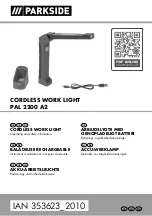
do the job better and safer at the rate for which it was designed.
- Do not use the power tool if the switch does not turn it on and off. Any power tool that cannot be
controlled with the switch is dangerous and must be repaired.
- Disconnect the plug from the power source and/or the battery pack from the power tool before making
any adjustments, changing accessories, or storing power tools. Such preventive safety measures reduce the
risk of starting the power tool accidentally.
- Store idle power tools out of the reach of children and do not allow persons unfamiliar with the power
tool or these instructions to operate the power tool. Power tools are dangerous in the hands of untrained
users.
- Maintain power tools. Check for misalignment or binding of moving parts, breakage of parts and any
other condition that may affect the power tool’s operation. If damaged, have the power tool repaired
before use. Many accidents
are caused by poorly maintained power tools.
- Keep cutting tools sharp and clean. Properly maintained cutting tools with sharp cutting edges are less
likely to bind and are easier to control.
- Use the power tool, accessories and tool bits etc. in accordance with these instructions, taking into account
the working conditions and the work to be performed. Use of the power tool for operations different from
those intended could result in a hazardous situation.
5) SERVIS:
- Have your power tool serviced by a qualified repair person using only identical replacement parts. This
will ensure that the safety of the power tools is maintained.
REFLEKTOR SAFETY INSTRUCTIONS
- Read the entire instruction manual before use and leave it with the product to allow the operator to
become familiar with it. If you lend or sell the product to someone, please also include this instruction
manual.
- The manufacturer is not liable for damages or injuries resulting from the use of equipment that is not in
accordance with this manual.
- Before using the light, familiarize yourself with all controls and components.
- Check all components are secure and check that any part of the light is not damaged, especially the front
guard and the cable adapter insulation. If the adapter feeder cable is also cracked, it is considered to be
damaged. Do not use the light with damaged parts and have it repaired by an authorized workshop.
- The light charger is designed to be plugged into a socket at the specified voltage. Before connecting, check
that the value in the socket matches the indicated values. Plug the charger terminal into the connector at
the rear of the lamp. Unplug the light from the charger after it has been recharged and do not leave it
connected to the charger for longer than necessary. After unplugging the charger terminal from the battery
connector, attach the cover to keep dirt such as metal dust, shavings and paperclips from entering the
connector and prevent the battery from short-circuiting and causing an explosion or fire. Also protect the
connector against undesirable water ingress.
- A flashing green LED indicates the battery is charging. The LED remains on when the battery is fully charged
but no longer flashes.
- NOTICE!
While the light is rain resistant and dustproof, this is not the case with the standard unprotected
230 V socket or the light charger. Keep the charger and socket protected against rain, moisture or any other
means of water ingress.
- Always use the light with an undamaged front guard to prevent damage to LEDs and exposure to moisture,
water and dust.
- Do not use the light in potentially explosive environments or close to a flame!
- For safety reasons, do not cover the light during use and keep a flow of ambient air. Also, do not install or
operate the lamp in a tight, small area with insufficient volume and air flow.
- The distance of the light from the illuminated object should be at least 1 meter.
- WARNING!
Protect the charger cable from thermal and mechanical damage.




































